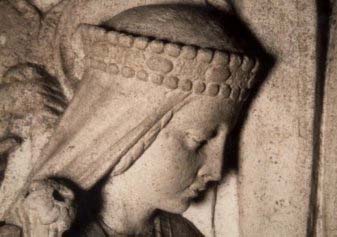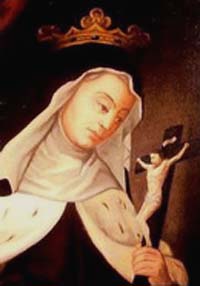 |
The Saint of the Day
Blessed Frances d’Amboise - November 5
Prof. Plinio Corrêa de Oliveira
Biographical selection:
Frances or Françoise d'Amboise (May 29, 1437 - November 4, 1485), was born in the Castle of Thouars. She was the daughter of the noble Louis d’Amboise, Prince of Talmont and Viscount of Thouars.

Frances d'Amboise, Duchess of Brittany
|
At age three she was engaged to Pierre, the second son of Jean VI, Duke of Brittany, for political reasons. She left her home and grew up under the care of Joan, her future mother-in-law, the sister of Charles VII, King of France. In 1442, at age 15, she married Pierre.
In 1450, her husband came to rule Brittany as Pierre II. Frances d'Amboise became the Duchess of Brittany and played an active role in governing Brittany. She helped the poor and the sick and was loved by the people. They would refer to this time as “the time of the blessed Duchess.”
Her husband died in 1457. King Louis XI wanted to marry her, but she would not give her consent. Under the orientation of Blessed Jean Soreth, she decided to enter the Carmelite Order. With the gifts of her properties, she founded the first convent of Carmelite nuns in France at Bondon, near Vannes. She also founded another convent in Nantes. Because of these foundations she is sometimes referred to as the Founding Mother of the Carmelites nuns in France. She died in the Convent of Nantes, on November 4, 1485. Her feast day is November 5.
Comments of Prof. Plinio:
As time passes, the number of priests and religious who are canonized has diminished. But the number of royal saints has become even sparser. In the Middle Ages there was a multitude, so to speak, of saints who were Empresses, Kings, princes and princesses. Blessed Frances d’Amboise is one of them. In the modern age almost no royal person has been canonized, one here and another there – but very rarely.

She ended her life as a Carmelite nun
|
We should include in our devotion the great feudal lords, princes and nobles who achieved the glory of the altars. They are symbols of royalty and feudalism introduced to the altars. In canonizing them, the Church indirectly recognizes the sanctity of the state they occupied in society.
If that condition were intrinsically unjust, as the French Revolution pretended, a feudal lord could not be a saint. If to be a feudal lord meant that one always oppressed and exploited the poor, a feudal lord certainly could not be a saint. For analogous reason a thief cannot be a saint. These are conditions essentially opposed to Christian virtue.
On the contrary, the life of Blessed Frances d’Amboise provides a good example of how that society was. She was a noble from a very good house who was raised by the sister of King Charles VII of France. Then she became Duchess of Brittany, where she carried her duties in an exceptional way. After her husband died, King Louis XI himself asked for her hand. We see, therefore, that she was a person highly placed in the ranks of nobility.
Her life reveals the great care she showed for religion and for the unfortunate poor of her time. Instead of exploiting the poor, as the revolutionary saga tells us the nobles always did, she was most benign to them, to the point that her goodness became legendary among them. Recalling her goodness, the little people of Brittany would refer with nostalgia to “the time of the blessed Duchess.”

The medieval fortress city of Vannes, above. During the French Revolution, the Carmelites were forced to abandon the convent and it became a prison, below.
 |
Certainly she was an outstanding person, much better than the average noble of that epoch, but not at variance with that average. Just as a tree produces flowers and fruits, so also the medieval feudal society produced its saints. The whole society was not necessarily composed of saints, but had an average proportion of good people, and even many bad people.
Just as a tree has roots, trunk and branches that often harbor insects and diseases, so the feudal society had people who were rude and bad. However, evil was condemned and was present in society as a foreign body. Society was not entirely composed of saints, but all the healthy parts - saints, excellent people, and the good and imperfect people - were linked to one another, as the parts of a tree. The life of Blessed Frances confirms this perspective.
We see that when she decided to leave the noble life behind and enter the Carmelite Order on the counsel of Blessed Jean Soreth, she did not make this decision because she was fleeing from an evil court ambience. On the contrary, that environment naturally spawned her resolution like a tree produces its flower. She decided to enter the life of Carmel; she sold her material goods; she founded two convents of Carmelite nuns, then she ended her blessed life in one of those Convents.
She chose this vocation not in opposition to the life of society, but as a way of life that represented the excellence of that temporal life she had before. Everything in the medieval civil life tended toward religion and the glory of God, so for the Duchess of Brittany to become the Founding Mother of the Carmelite nuns in France is like a fruit that is plucked from the tree after it has ripened.
Blessed Frances d’Amboise is one of those of many medieval Saints that are symbols of their epoch and should be considered patrons of the Christian temporal order. Therefore, it is proper for us, who fight for the defense and restoration of Catholic Civilization, to ask them to protect our action. If they were alive, they would be fighting with us. So we should have their names on our personal calendars.
Let us ask Blessed Frances d’Amboise to help us to restore Christendom so that the future society – like the one of her time – may exist to glorify God.


  | | Prof. Plinio Corrêa de Oliveira | |
The Saint of the Day features highlights from the lives of saints based on comments made by the late Prof. Plinio Corrêa de Oliveira. Following the example of St. John Bosco who used to make similar talks for the boys of his College, each evening it was Prof. Plinio’s custom to make a short commentary on the lives of the next day’s saint in a meeting for youth in order to encourage them in the practice of virtue and love for the Catholic Church. TIA thought that its readers could profit from these valuable commentaries.
The texts of both the biographical data and the comments come from personal notes taken by Atila S. Guimarães from 1964 to 1995. Given the fact that the source is a personal notebook, it is possible that at times the biographic notes transcribed here will not rigorously follow the original text read by Prof. Plinio. The commentaries have also been adapted and translated for TIA’s site.
|
Saint of the Day | Home | Books | CDs | Search | Contact Us | Donate

© 2002- Tradition in Action, Inc. All Rights Reserved
|
 |

|